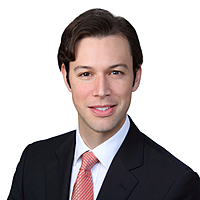Macro and policy trends remain key drivers of fixed income volatility
With inflation top-of-mind for investors, we believe the Federal Reserve’s reaction function will likely be a key driver of real yields, the dollar and risk markets this year. Although we anticipate that inflation levels will ease, the decline will likely be shorter-lived and shallower than some expect. Meanwhile, policy actions by the Fed and other central banks are likely to drive increased levels of market volatility, and thus impact investment strategy moving forward.
What are the implications?
- Inflation could start to decline as some key drivers begin to moderate; however, reductions could be shorter-lived and shallower than some expect.
- The evolution of inflation and central bank policy will likely drive higher market volatility in 2022.
- Investors should maintain defensive positioning to interest rates, particularly in the U.S.
- We favor overweighting credit markets, although less than in 2021. Fundamental credit risk remains limited, benefiting high yield over investment grade. European credit offers slightly more value than U.S. credit.
- Emerging markets hard currency debt appears attractive given EM’s earlier start on tightening and last year’s underperformance.
- Cash and floating-rate securities in the ABS, CLO, bank loan and corporate credit markets offer flexibility in the event of enduring inflation; TIPS seem fully priced at these levels.
Persistent inflation and policy-driven volatility
As we wrote last quarter, we expect higher volatility in bond markets this year. Drivers of volatility are unlikely to be
fundamental—household and corporate balance sheets remain strong, and, with the possible exception of China (as we
discuss in more detail below), the global growth cycle remains supportive of both corporate and securitized credit markets.
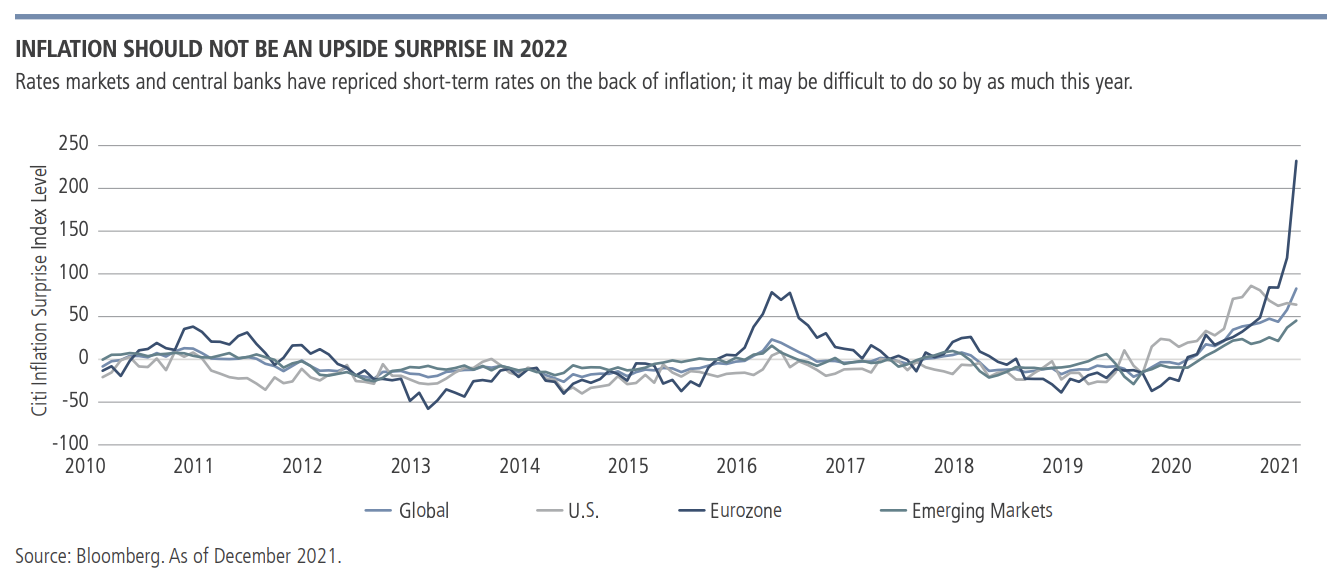
Rather, the drivers of volatility in 2022 will likely be macro and policy trends—specifically, the evolution of inflation and central bank policy.
Inflation is top-of-mind for global bond investors. We enter 2022 with core inflation in regions as varied as the U.S., Europe and emerging markets at elevated levels. With the U.S. at 4.9% core inflation, Germany at 4.1%, Mexico at 5.7% and Poland at 4.7% (as a few examples), the debate is not about whether inflation will exceed central bank targets, but for how long.
We expect that the movements in U.S. inflation will be the most critical for markets in the first quarter. With emerging markets already responding to higher inflation prints with policy adjustments, and the European Central Bank clearly “looking through” the elevated prints, we believe it is the Federal Reserve’s reaction function that will be most important as a driver of real yields, the dollar and risk markets in general.
What do we expect for U.S. inflation? We agree with market consensus that inflation measures will start to decline as some key drivers of higher inflation, particularly car prices, start to moderate. However, we think the declines in inflation will be shorter-lived and shallower than Street expectations. The key reason is housing inflation; we expect persistent levels in this area as well as pressure from wages on other goods and services. As a result, we believe inflation could easily remain at 3% or more throughout the year.
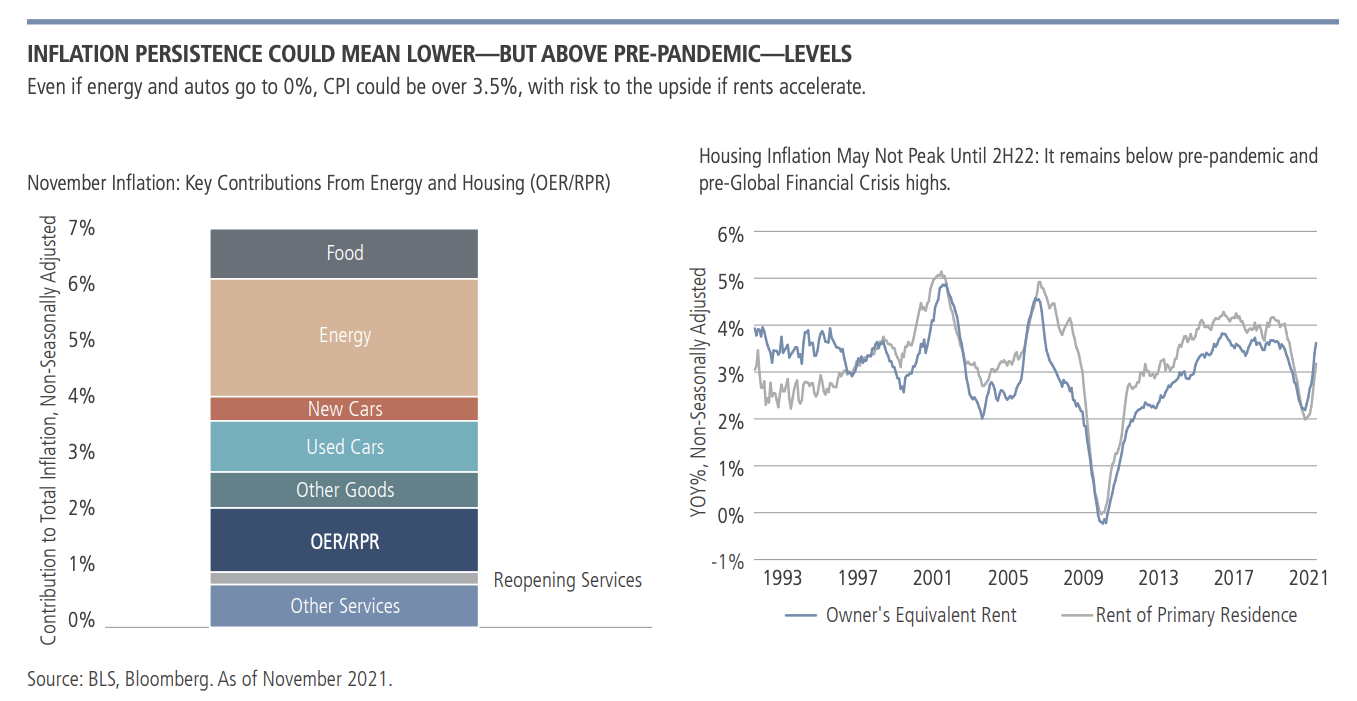
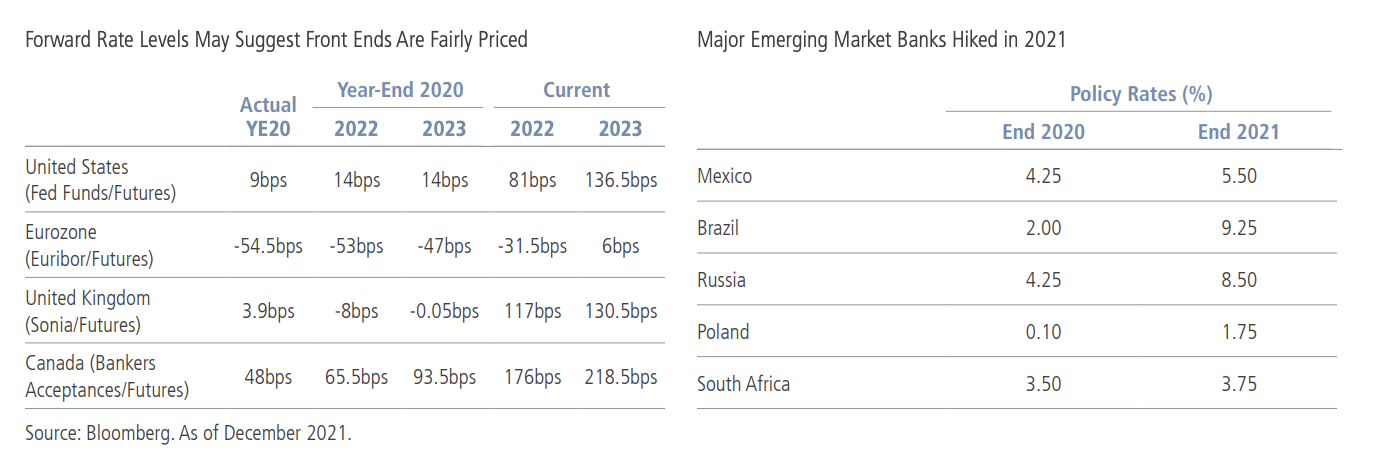
A second potential driver of volatility, related to persistent higher inflation, is the market’s expectation for a global hiking cycle. It’s important to note that this is primarily a developed market theme for 2022, as many large emerging market central banks have already begun tightening. This year, it will be the Fed’s and other G7 central banks’ turn to raise short-term rates.
What do we expect from these central banks? The table below highlights our expectations for many of the G7 countries. A few key themes are apparent in our expectations:
- We expect three to four hikes from many of the key central banks, including the Fed, Bank of England and Bank of Canada. Generally, we expect slightly more hiking than markets are currently pricing.
- The ECB is a notable exception to the global developed market hiking cycle—similar to other periods over the past decade; while other central banks are on the move, we expect no changes to the ECB’s negative overnight rate setting.
- The hiking cycle in 2022 will be much more about ending “emergency” policy than attempting to significantly slow global growth—this is about a partial return to pre-COVID policy rather than anything more significant. As such, although policy will be in motion, we don’t expect these changes to drive fundamental changes in the global growth environment.
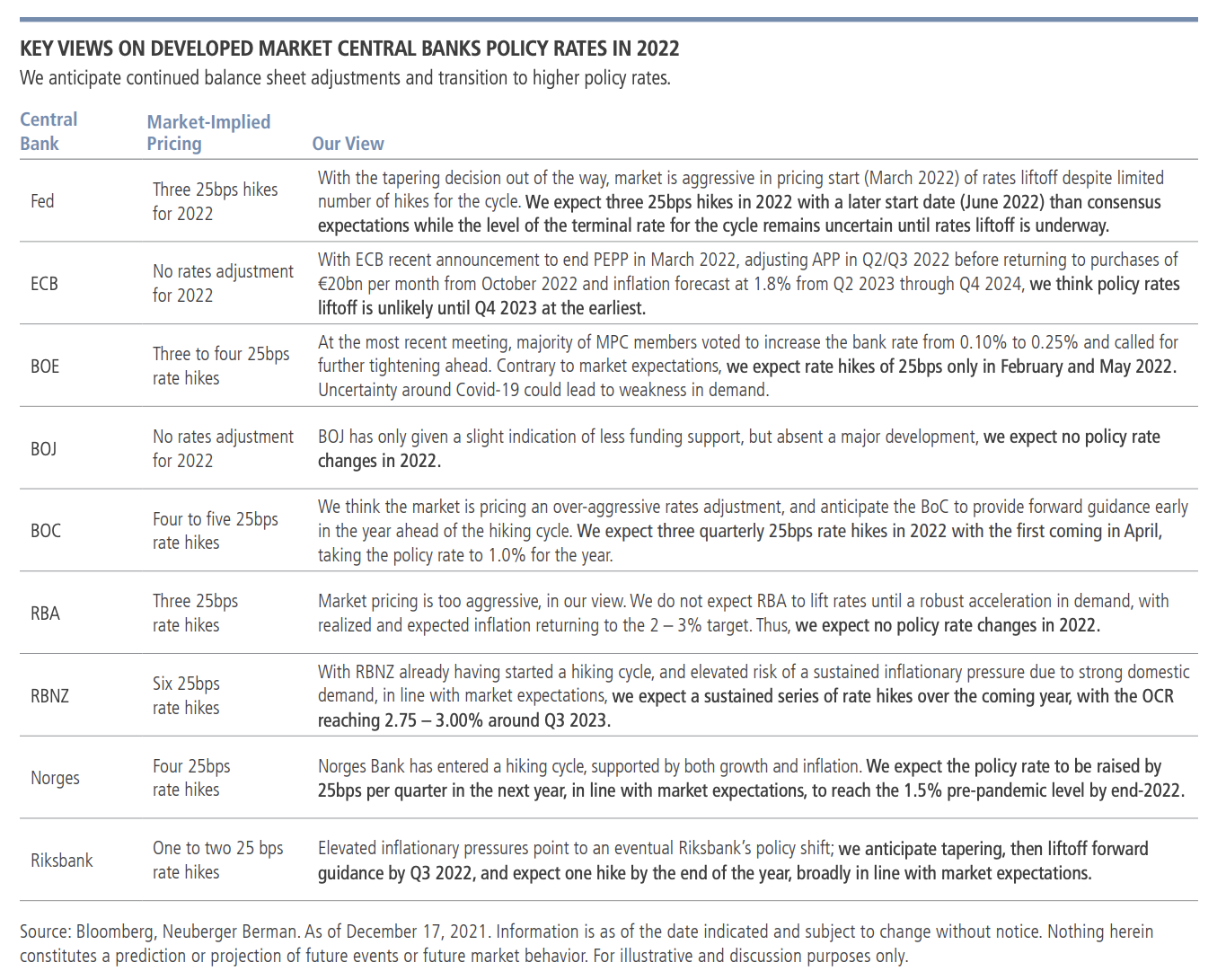
In addition to raising short-term rates, both the Fed and ECB have already committed to a wind-down of their bond purchase programs. In December, the Fed announced an acceleration of its tapering of U.S. Treasury and mortgage purchases, and those purchases should cease by March. The ECB announced a similar policy: Its pandemic purchase program (PEPP) will also end in March, although the ECB will continue purchasing assets under its more general asset purchase program.
While the Fed’s transition from “on hold” to tightening policy has been well telegraphed, more complicated policy decisions are being made by the ECB and People’s Bank of China (PBoC), and markets will likely have rising sensitivity to these two central banks in particular.
For the ECB, the key reason we expect unchanged policy relates to the durability of economic trends in Europe. We expect the central bank to be hesitant to forecast inflation higher than its 2% target (and thus signal tighter policy) unless and until it sees lower unemployment rates and higher wage increases. For the markets, we expect increased focus on specific factors that could influence the timing of further policy changes: consumption momentum as economies reopen, whether next-generation funds support higher domestic growth, and how trends in inflation (excluding base effects) develop, having affected German inflation rates in particular.
Likewise, the PBoC faces increased challenges in 2022. Unlike other developed banks, the PBoC will likely still be biased toward easier policy, with an emphasis on supporting growth and not asset speculation. In practice, we believe the PBoC will cut the rate on its medium-term lending facility by 10 basis points to 2.85%, and will further cut the reserve ratio requirement by 50 bps to 11%. In addition, the central bank is likely to lean heavily on its relending facility in 2022 to more directly promote lending toward its desired sectors, and has announced a CNY1 trillion relending quota for green financing.
More broadly, China is aiming for higher growth this year, against a backdrop of continued rebalancing of growth drivers. The Central Economic Work Conference (CEWC), which concluded in December, refocused policy priority toward growth, and suggested a more supportive policy environment for 2022. We think the government will set a growth target of 5% or above for 2022. The pace and intensity of regulatory tightening are likely to be adjusted to prevent systemic risks. Fiscal policy could do the heavy lifting in the first half of 2022 with the CEWC directing spending to be ramped up and frontloaded. The government will likely announce a 6% fiscal deficit for 2022, slightly higher than the estimated fiscal deficit of 5 – 5.5% in 2021.
While inflation rates and how they may impact central bank policy
will likely be the two largest drivers of volatility this year, a few other
developments should be highlighted as well.
One trend we are monitoring is the potential for merger and acquisition
activity within the investment grade credit market. Over the past two
years, these transactions—which often involve higher leverage—have
been relatively muted. As the display above highlights, the last couple of
years have been relatively unusual and a return to more typical levels of
M&A activity would likely create some modest headwinds for investment
grade spreads.
Second, housing price appreciation has helped support a range of securitized assets. As shown on page 6, house prices and affordability levels in the U.S. have seen significant movement in the past three years. While a support for seasoned securities, new issuance in these markets in 2022 is starting from more elevated valuations. Given our expectation for more modest housing appreciation in the coming years, divergences in these markets are likely only increasing.
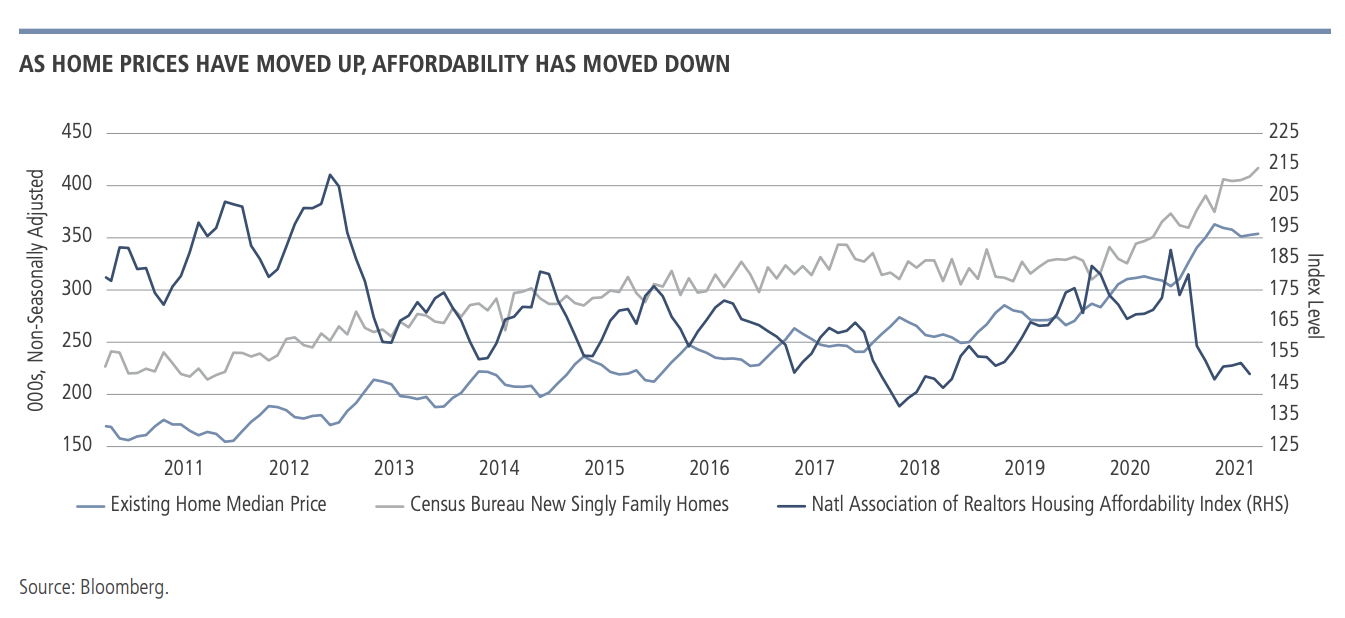
Finally, the importance of environmental, social and governance factors in the credit market continues to increase. Whether climate change, equity inclusion and diversity, or general corporate governance, we expect more regulatory clarity on these issues (particularly in Europe) in 2022, which could further accelerate the trend toward leading-edge issuers. At the same time, we expect the energy sector to continue to be volatile in 2022. A strong performer in 2021, these markets should continue to be supported by strong commodity prices while facing headwinds given ESG concerns.
In terms of how to position fixed income portfolios this year, we are
focused on four key ideas:
- Maintain defensive positioning to interest rates, in the U.S. in particular. We expect the bond market to reprice the Fed’s terminal rate as growth and inflation exceed the Fed’s targets. We believe a repricing toward a 2.25% terminal funds rate (from 1.75% currently) is a reasonable expectation. This would likely imply a 10-year Treasury note target of approximately 1.85 – 2.00%. Given that the ECB will be on hold in 2022, we believe defensive positioning in U.S. rates will likely be appropriate in the near term.
- Overweight credit markets, less so than in 2021, and be prepared to buy on dips. Similar to the past few years, fundamental credit risk remains limited. For example, we expect sub-1% default rates in high yield markets, which speaks to the strength of corporate balance sheets and the growth environment. If macro risks disrupt credit markets, investors should be prepared to add exposure. Within credit markets, we prefer high yield to investment grade, while European credit markets offer slightly more value than U.S. markets. Particularly in non-investment grade, we believe investments in telecommunications and technology sectors offer the most relative value. In investment grade, we continue to like BBB companies with spread advantages. This includes telecom, cable/media and technology. We continue to think U.S. banks provide attractive valuations. Corporate hybrids continue to provide attractive yield advantages, but the spread compression opportunities are currently limited. Energy is not attractive at these current valuations, in our view, even at elevated oil prices. Finally, taxable municipals should be an area of focus given spreads to investment grade credit.
- Increase allocations to emerging markets hard currency debt. After relative underperformance to other credit markets in 2021, we expect that EM will do better in 2022. There are two main reasons. The first is valuations: EM is trading at one of the cheapest levels to corporate credit in the U.S. and Europe that we’ve seen over the past five years. The second relates to the cycle: EM is further advanced in the tightening and fiscal adjustment cycles than developed markets. Within EM, we see opportunities in the high yield hard currency space, select opportunities in the investment grade hard currency space, and Chinese securities.
- Maintain inflation protections in portfolio. At current valuations, we prefer cash and floating-rate securities in the ABS, CLO, bank loan and corporate credit markets as a way to maintain flexibility toward higher inflation rates. A repricing of TIPS and/or other inflation markets will offer a direct way to position for enduring inflation, but at current valuations, we prefer emphasizing other assets to achieve this goal.

Learn more about the Neuberger Berman Strategic Income Fund
The Strategic Income Fund is a flexible, multi-sector fixed income strategy that seeks consistent monthly income by investing across the entire bond market with a focus on exploiting mispriced securities. Click here to find out more about the fund. In the build up to my upcoming visit in March this year, please click 'FOLLOW' below for first access to my insights.
1 fund mentioned
